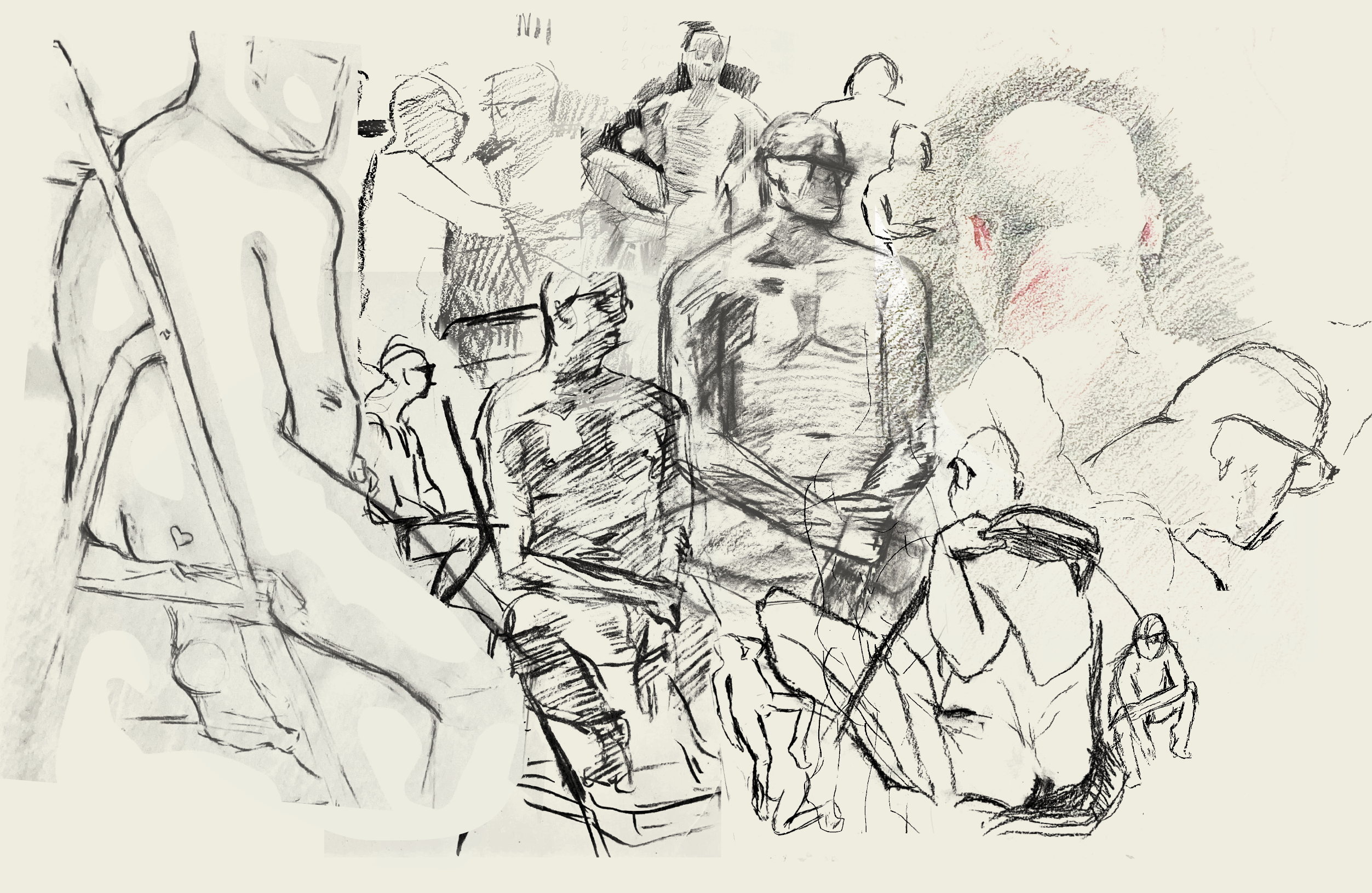Soft scrapes echo through the slowly filling room. Drafting desks are rolled around, adjusted, hung flat, or hitched high, accompanied by quiet chatter in various corners. The desks settle in a ring around a center platform where the model—Babs New, a regular—idles, still enrobed, waiting for the session to begin.
Most Fridays, from 2 p.m. to 5 p.m., Georgetown’s Department of Art and Art History hosts free, open-access figure drawing sessions. The only thing a prospective artist needs to bring is themself and the willingness to get their hands a little dirty. Charcoal tends to get everywhere when you’re engrossed in the work.
Figure drawing is the practice of sketching the human form from real-time observation. A model, typically nude, shifts between poses intermittently, while artists are tasked with drawing what they see. It’s easier said than done—while figure drawing is uncomplicated to practice, it is understatedly difficult to master. However, the goal of these sessions is not to master the art form; it’s to learn.
The sessions flow in 20-minute intervals, with poses that gradually increase in duration as the afternoon proceeds. We begin with 30-second warm-ups with little to no warning between switches in pose. Smooth Brazilian jazz fills the space as the artists quiet and Babs disrobes, taking their place in the room’s center and assuming a languid, splayed-leg stance. Their back is to me, and I squint at its contours briefly before bearing down on my page.
The first pose is always the roughest. My first sketch, vine charcoal on gray newsprint, is stiff, disproportionate, and more significantly, headless. Focused on the angles of their legs, I barely make it to Babs’s neck before the timer rings out, and they take to the floor in an articulated squat.
The urgency of the 30-second poses forces artists to work in looser, more expressive strokes and to see the figure as one larger form rather than its individual elements.
To sketch in these conditions is to abandon any preoccupation with style or detail. It’s a paradoxical practice: by loosening the reins on their process, artists enter a headspace where control comes more easily, without the white-knuckle tension it typically implies.
As Andrew Kim (CAS ’25), an art minor, put it, “After the first couple times, you just kind of turn your brain off and it’s like, ‘Okay, there’s an arm. There’s a leg. There’s this muscle and that muscle.’”
You learn to accept that you can’t agonize, micromanage, or mete out a course of action moment-by-moment. It’s a very Georgetown kind of lesson to learn, and it’s part of what makes the space so distinct for art students and non-artists alike.
Seated across from me is Marisa Stratton, who runs the sessions. An adjunct professor in the Department of Art and Art History, Stratton is young and easygoing—you’d be forgiven for mistaking her for a student, as her energetic demeanor conceals the practiced grace with which she guides the sessions forward.
In the years before COVID-19, figure drawing sessions had existed on and off at Georgetown, but they had disappeared completely by Stratton’s first semester here in spring 2023. It had been her initiative to revive them, convinced of the value they’d bring to the campus’s relatively small and underserved community of artists. “I knew that in order to build community you need a space outside of the classroom,” Stratton said. “It really just requires one faculty to have the extra time to host the sessions.”
When she first restarted the sessions, they had much lower attendance, mostly art majors and minors. That core group has remained consistent, but the sessions have, largely through word of mouth, grown immensely in attendee count and diversity. Stratton said the Department of Art and Art History has been excited to facilitate such a range of student engagement with the arts.
If the size of the sessions has changed, the ethos behind them has not. The first rule of figure drawing is to be considerate of one another and the model’s privacy. Between breaks, while the model is unrobed, the door is shut tight. The second rule: there are no other rules.
There is very little in the way of active instruction over the three-hour session: artists are free to come and go as they please. It’s a startling level of autonomy for students used to operating under strict schedules and dizzying deadlines.
“It gives me something to focus on that isn’t life and all of its problems. When I’m doing the drawings, I’m very focused on it and it’s harder to be distracted by other things that might be on my mind,” Sofia Doroshenko (SFS ’24), a repeat attendee, said. “Which is rare, I think, compared to the rest of Georgetown, which is overstimulating in my opinion.”
The relaxed, free-flowing nature of the sessions is by design. “I feel like figure drawing is such a great space because there aren’t any expectations, there aren’t any limitations,” Stratton said. “I’m not enforcing anything, people can move at their own pace, they can leave if they want, and I think it creates a really great environment where everyone wants to be there.”
Stratton’s creation of a space largely driven by students’ curiosity and determination to create provides a unique, strings-free experience and an environment in which drawing is valued just for the sake of doing it. On top of the limitations created by an underfunded department, extracurricular opportunities for visual arts on campus exist largely in pre-professional contexts, to a demoralizing degree.
In most club and internship environments, those with experience in the arts are pigeonholed into marketing, advertising, or social media management roles. Art is associated with increasing profits rather than personal enrichment. It is created under expectation, detached from its nature as a form of self-expression and self-inquiry, and ran through filters of marketability.“I think a lot of people who come to figure drawing are really hungry to keep art in their lives,” Stratton said, acknowledging the difficulty of maintaining an artistic connection in the whirlwind of student life. “Even if they can’t fit in a minor, or can’t declare a major, or anything like that, you can still see that people really need this space.”
Brigid O’Connor (CAS ’26) is one of many students who have found a home in the space. “I feel like that has been one of the niche places where I have been able to find a community of artists on campus here,” O’Connor said. “There are not really that many free art opportunities on campus. It’s really hard to get into the art classes if you’re not a major or minor, because they’re so small and because the department’s so small.”
The limitations of the department’s size are felt by all members of the campus community. Graduate and continuing students, for instance, are explicitly not permitted to take or audit—or even TA—undergraduate art courses, despite overwhelming interest.
These restrictions explicitly informed Stratton’s efforts to create a universally inclusive space for the arts. “Creating a space outside the classroom where there’s no limitations or requirements was really important for growing the [arts in the] broader Georgetown community,” Stratton said. “Faculty can come to figure drawing, and faculty have come to figure drawing. So you have grad students, faculty, and staff at Georgetown, too.”
Fabiola Diaz Ruiz (G ’27), a third-year physics doctoral candidate, found her way to the sessions while seeking a reprieve from academia. “Since I’m in physics, all that I do most of the week is very technical work,” she said. “But, you know, I also have a very creative side that I think needs a good outlet. For me, coming here, even if it’s just a few hours a week, is really a nice time to do something entirely different.”
Diaz Ruiz recounted an old art teacher’s sentiment about the people-centered aspect of figure drawing that has always stuck with her: “He told me that there’s just something about drawing people that really helps you draw because you have this connection that you maybe wouldn’t have with, like, a pencil or a table.”
To Stratton, too, people lie indelibly at the heart of her creative journey. She has always found community in her pursuit of artistry, and it’s reflected both in the praxis of her classroom and in the environment she’s created through the figure drawing sessions.
“I think I always knew teaching would be a part of my life, even when I hadn’t started yet. I think it’s because teaching is social, and a lot of my painting is very social as well—I work in portraiture, so people are essential to my personal practice,” Stratton said. “And, for me, social engagement is very wrapped up in art making.”
It’s the undemanding social environment that makes it so easy for newcomers to engage meaningfully with the making of art, even if they only attend one or two sessions. Week after week, the room features a revolving door of attendees. Many see the space as a unique way to spend a Friday afternoon or otherwise get convinced to go by a friend: there are just as many one-timers as regulars.
Doroshenko, who roped her roommate into coming to a session last month, believes they have something to offer everyone. “It’s just a different way of thinking and it’s just so different, and I think that even people who are maybe not so used to drawing, maybe they’re just starting out, I still think it’s a good experience,” she said. The sessions’ high turnover rate is not an indictment of their worth; it speaks, instead, to the value they bring to parts of the community that would otherwise have had no exposure to them.
To this, Kim agreed wholeheartedly. “I think everybody should try it. Like, everybody.”
The Department of Art and Art History’s open figure drawing sessions are hosted Fridays from 2 p.m. to 5 p.m. in Walsh 395, running until April 26.
Special thanks to Emily Higgins, Sammi Huebner, Marisa Stratton, Fabiola Diaz Ruiz, Sophia Frank, Andrew Kim, and Elli Ahn for contributing their sketches.




